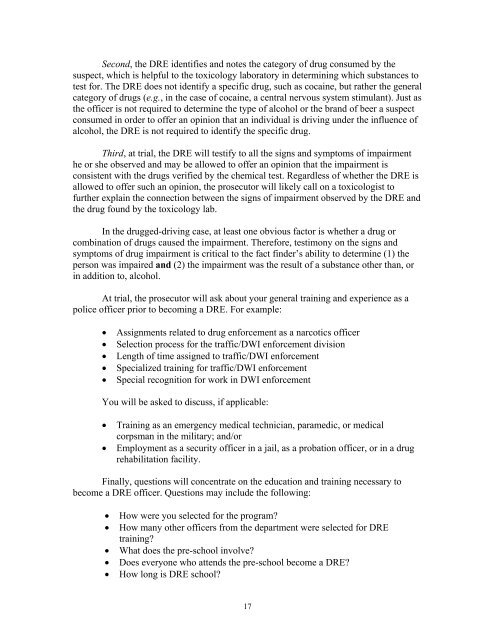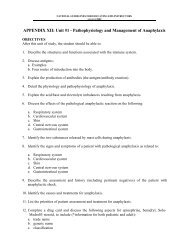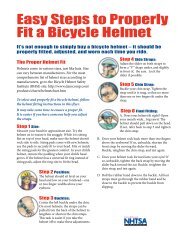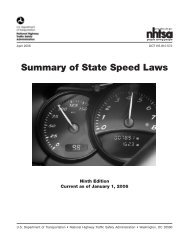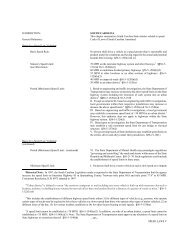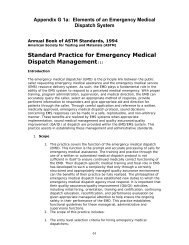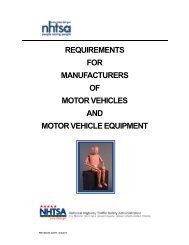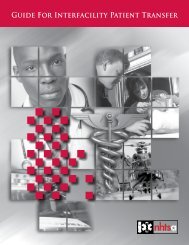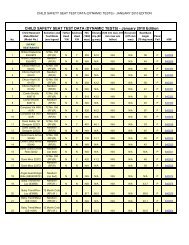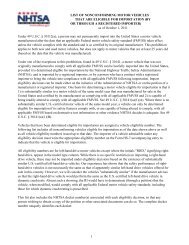The Criminal Justice System: A Guide for Law Enforcement ... - NHTSA
The Criminal Justice System: A Guide for Law Enforcement ... - NHTSA
The Criminal Justice System: A Guide for Law Enforcement ... - NHTSA
Create successful ePaper yourself
Turn your PDF publications into a flip-book with our unique Google optimized e-Paper software.
Second, the DRE identifies and notes the category of drug consumed by the<br />
suspect, which is helpful to the toxicology laboratory in determining which substances to<br />
test <strong>for</strong>. <strong>The</strong> DRE does not identify a specific drug, such as cocaine, but rather the general<br />
category of drugs (e.g., in the case of cocaine, a central nervous system stimulant). Just as<br />
the officer is not required to determine the type of alcohol or the brand of beer a suspect<br />
consumed in order to offer an opinion that an individual is driving under the influence of<br />
alcohol, the DRE is not required to identify the specific drug.<br />
Third, at trial, the DRE will testify to all the signs and symptoms of impairment<br />
he or she observed and may be allowed to offer an opinion that the impairment is<br />
consistent with the drugs verified by the chemical test. Regardless of whether the DRE is<br />
allowed to offer such an opinion, the prosecutor will likely call on a toxicologist to<br />
further explain the connection between the signs of impairment observed by the DRE and<br />
the drug found by the toxicology lab.<br />
In the drugged-driving case, at least one obvious factor is whether a drug or<br />
combination of drugs caused the impairment. <strong>The</strong>re<strong>for</strong>e, testimony on the signs and<br />
symptoms of drug impairment is critical to the fact finder’s ability to determine (1) the<br />
person was impaired and (2) the impairment was the result of a substance other than, or<br />
in addition to, alcohol.<br />
At trial, the prosecutor will ask about your general training and experience as a<br />
police officer prior to becoming a DRE. For example:<br />
• Assignments related to drug en<strong>for</strong>cement as a narcotics officer<br />
• Selection process <strong>for</strong> the traffic/DWI en<strong>for</strong>cement division<br />
• Length of time assigned to traffic/DWI en<strong>for</strong>cement<br />
• Specialized training <strong>for</strong> traffic/DWI en<strong>for</strong>cement<br />
• Special recognition <strong>for</strong> work in DWI en<strong>for</strong>cement<br />
You will be asked to discuss, if applicable:<br />
• Training as an emergency medical technician, paramedic, or medical<br />
corpsman in the military; and/or<br />
• Employment as a security officer in a jail, as a probation officer, or in a drug<br />
rehabilitation facility.<br />
Finally, questions will concentrate on the education and training necessary to<br />
become a DRE officer. Questions may include the following:<br />
• How were you selected <strong>for</strong> the program?<br />
• How many other officers from the department were selected <strong>for</strong> DRE<br />
training?<br />
• What does the pre-school involve?<br />
• Does everyone who attends the pre-school become a DRE?<br />
• How long is DRE school?<br />
17


